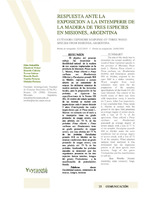Respuesta ante la exposición a la intemperie de la madera de tres especies en Misiones, Argentina
Outdoors exposure response of three wood species from Misiones, Argentina
Date
2016-12-01Author
Bobadilla, Elisa Alicia
Weber, Elizabeth María
Callaba, Ricardo Eugenio
Suirezs, Teresa María
Barth, Ricardo Cristino
Pereyra, Yamila Mariel
Pereyra, Obdulio
Metadata
Show full item recordAbstract
El objetivo del presente trabajo fue determinar la durabilidad natural de la madera de tres especies implantadas en la provincia de Misiones: Pinus taeda L. Marion, Pinus elliottii x Pinus caribaea var. Hondurensis (hìbrido) y Eucalyptus grandis Hill ex Maiden, expuestas a campo abierto en un cementerio de estacas. Se utilizaron muestras de madera aserrada de las industrias locales, para la preparación de las probetas, se siguieron las especificaciones de la Norma EN 252. El control del estado sanitario de las mismas se realizó con inspecciones cada 6 meses durante 2 años. Concluyendo las cuatro inspecciones que: el Pinus taeda L. Marion en contacto con el suelo a la intemperie tiene un grado promedio de ataque severo, con una pérdida del 73 % de las probetas. Pinus elliottii x Pinus caribaea var. Hondurensis tiene un grado promedio de ataque severo, con una pérdida del 77 % de las probetas. Eucalyptus grandis Hill ex Maiden en las mismas condiciones tiene un grado promedio de ataque severo, con una pérdida del 73 % de las probetas. Analizadas las probetas atacadas se determinó que los organismos presentes en las tres especies fueron termitas, hongos del genero Trichoderma y la manifestación de podredumbre blanda. The aim of this study was to determine the natural durability of wood of three implanted species in the province of Misiones: Pinus taeda L. Marion, Pinus elliottii x Pinus caribaea var. Hondurensis (hybrid) and Eucalyptus grandis Hill ex Maiden, exposed to the open field in a stakes cemetery. Wood samples from local industries were used for the preparation of the samples; specifications of the Norm EN 252 were followed. The control of the health status of them was done with inspections every 6 months for 2 years. After four inspections, it was concluded that: Pinus taeda L. Marion in contact with the ground in the open field presented an average degree of severe attack, with a loss of 73 % of the specimens. Pinus elliottii x Pinus caribaea var. Hondurensis presented an average degree of severe attack, with a loss of 77 % of the samples. Eucalyptus grandis Hill ex Maiden under the same conditions had an average degree of severe attack, with a loss of 73 % of the samples. When attacked samples were analyzed, it was determined that the organisms present in all three species were termites, fungi of the genus Trichoderma and the manifestation of soft rot.
URI
https://hdl.handle.net/20.500.12219/2677http://www.yvyrareta.com.ar/index.php/component/k2/item/43-respuesta-la-exposicion
Collections
- Revista Yvyraretá [360]
The following license files are associated with this item:




